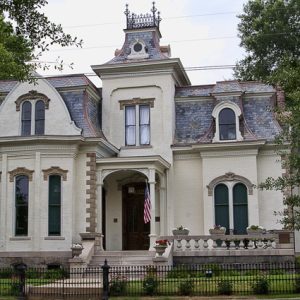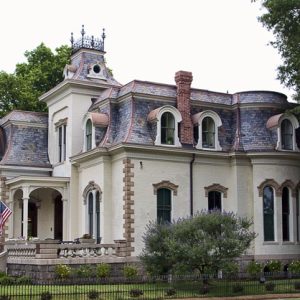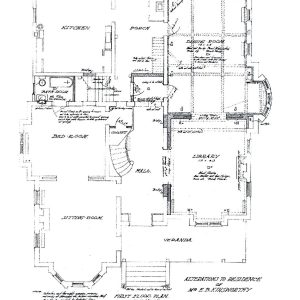calsfoundation@cals.org
Villa Marre
In 1881, Angelo and Jennie Marre built an elegant family home at 1321 Scott Street in Little Rock (Pulaski County), and 125 years later, its façade became familiar to millions of people around the world through its appearance in the opening credits of a popular television show. Television producers and former Arkansas residents Harry Z. Thomason and his wife, Linda Bloodworth-Thomason, used the home’s exterior to depict the design firm run by the main characters of the couple’s CBS television series, Designing Women. The house—which has weathered storms, architectural changes, urban renewal, and neglect—is still one of Little Rock’s most prominent landmarks.
After amassing a fortune in the liquor import and saloon business, Marre began to build his home, which likely served as a visible reminder of his Italian heritage. Twelve-year old Marre arrived in the United States from Borzonaca, Italy, in 1854. Constructed in the Second Empire architectural style with Italianate influences, the predominant feature of the home is its Mansard roof, which is adorned with multi-colored rectangle slates interspersed in a decorative fish-scale motif. The house also shows the influence of Italianate style with its tall, narrow windows and a tower centered on the front façade. Quoins made of concrete stones that accent the corners of the house placed in an alternating or stacked position are a decorative element and characteristic of both Italianate and Second Empire architectural styles. Prominent interior features include a sweeping walnut staircase, frescoed and mural ceilings, and lavish woodwork. The completion of the home took approximately one year, and its initial value was listed as $5,000.
After the death of Angelo Marre in 1889, followed by the death of his wife in 1904, the house was sold to a variety of owners and served as a nursing home, a rental property, a dance studio, and an Alcoholics Anonymous meeting facility before being condemned by the city in 1964. While waiting for the bulldozers, owner Mary Morris sold the house to James W. Strawn Jr. for the sum of $11,550 on January 29, 1964. Strawn, the owner of a successful furniture company, became interested in architectural restoration as he watched many Little Rock’s fine homes and buildings being bulldozed during urban renewal efforts.
After two years of renovations, Strawn christened the home the “Villa Marre” in honor of its builders. Upon its completion, he sought a guardian to insure the home never fell into neglect again. In 1979, Strawn gave the building, one of Little Rock’s finest examples of nineteenth-century architecture, to the Quapaw Quarter Association, which assumed responsibility for its preservation. Due to its significant history, the Villa Marre was placed on the National Register of Historic Places in 1970.
Scott Street, once an elegant address, became an avenue of derelict homes after World War II but is now recovering, along with much of downtown Little Rock, through the preservation work of many. The Villa Marre became a private residence in 2002, and its furnishings were sold at a public auction. In January 2012, Toni and Ron Lazenby of Little Rock, along with sons Ryan and Aaron, purchased the home with the aim of turning the second floor into office space and making the first floor available for reception rentals. The property was purchased in March 2019 by attorney and former Arkansas General Assembly member Steve Harrelson.
For additional information:
Maack, Jo Ellen. “Behind Closed Doors: The Inside Story of the Villa Marre.” MA thesis, University of Arkansas at Little Rock, 2003.
“Villa Marre (Angelo Marre House).” National Register of Historic Places nomination form. On file at Arkansas Historic Preservation Program, Little Rock, Arkansas. Online at http://www.arkansaspreservation.com/National-Register-Listings/PDF/PU2909.nr.pdf (accessed January 29, 2021).
Villa Marre File. Quapaw Quarter Association, Little Rock, Arkansas.
Jo Ellen Maack
Old State House Museum
 Steve Harrelson
Steve Harrelson  Villa Marre
Villa Marre  Villa Marre
Villa Marre  Villa Marre First Floor
Villa Marre First Floor  Villa Marre Second Floor
Villa Marre Second Floor 




Comments
No comments on this entry yet.